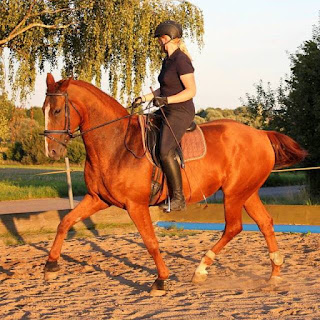Last summer I had the pleasure to attend a symposium with the topic "Optimizing horse's straightness, balance & performance through fascia retraining and postural rehabilitation" by now sadly late Dr. Kerry Ridgway. He was accompanied by Manolo Mendez and Colonel Carde on the stage. I had already my own understanding about many of the issues sports horses have before this clinic took place, but the symposium really gave a confirmation to some of the things I had discovered through my work in rehabilitating horses with a broad scale of different physical problems.
There are a lot of horse trainers in the world, especially in the field of dressage, who obsess about horses' hind legs as if they would be the sole part of horse's body that carries weight and moves the horse's body. This then resulting into forward driving and holding back at the same time for the sake of "collecting a horse".
But as we all should know, horse is an animal with four legs and an animal, who carries most of his body weight with the front legs. A horse is naturally asymmetric and so to say "right- or left-handed". Dr. Ridgway pointed out that through his own personal experience about 80% of the horses are right-handed, the rest left-handed - quite like with us people. A right-handed horse loads more body weight onto the right front leg, which also especially from the saddle perspective "seems to be stuck underneath the front of the horse". The right front leg also due to its weight carrying properties has a different mechanism in the movement: it tends to do shorter, stompy strides where as the left front leg does a normal pattern. A very asymmetric horse might appear almost lame because of the difference in the front leg movement.
This asymmetry naturally goes through out the horse's body. The hind legs are also specialized: the right hind leg of a right-handed horse is better at carrying weight, the left one is specialized in pushing the movement forward. The more the left hind leg pushes and the less the right front leg spends time in the air, the more the horse will fall onto the front legs, to the right and get also heavier on the rein.
Through my personal experience the horse's neck also has a big impact on the ridability. A right-handed horse pushes the base of his neck in front of the right shoulder. As long as the base of the neck is placed more to one side, the horse will feel stiff to turn and flex to that side.
The interesting thing is that once these balance related issues are corrected, the horse's one-sided ridability problems seem to vanish one after the other.
A right-handed horse leans against the rider's right leg and offers more contact in the right rein. Quite a few riders try to solve the one-sidedness by flexing and over-flexing the neck of a right-handed horse to the right, possibly while also driving more forward with their legs. This only makes the problem worse as the horse reacts to the pull of the rein not by pushing the base of his neck to the other side, which would be helpful, but actually pushing the weight of the front harder onto the right front leg. The horse gets heavier in the right rein, rider pulls more, horse gets even heavier... I think you got the picture.
How to solve this problem is first to neutralize the horse's body position between left and right. A balanced, neutral horse has the center of gravity in the middle of its body, the body weight evenly distributed onto all four legs.
 |
| A young warmblood gelding, photo Cat Loose |
When the horse is balancedly on all its four hooves, the base of the neck in the middle of its front legs, the horse will always be supple and flexible from its body and neck, if there are no other issues in his body (such as blocked joints, cramped muscles, to which the remedy is a well educated physiotherapist). Naturally for the horse to move with a healthy mechanism, he also needs to get the body weight off from the front legs. That we call collection.
 |
| A young Finnhorse gelding, photo Cat Loose |
A horse who can move its feet parallel is a horse who is ridable. An equal lift in the shoulders with an equal push in the hind quarters creates a bridge of energy and balance over the horse's body.
A rider should never forget that riding a horse in balance is a game of all four legs. When there is symmetry in all of them, there is the wanted level of ridability with all the wanted qualities.
The fabulous system of the horse's body is worth studying. An interesting document about the features of a (racing) horse you will find from this link: https://www.youtube.com/watch?v=QsvS6gEBJuE
 |
| An adult Hanoverian mare with a higher level of collection, photo Cat Loose |
